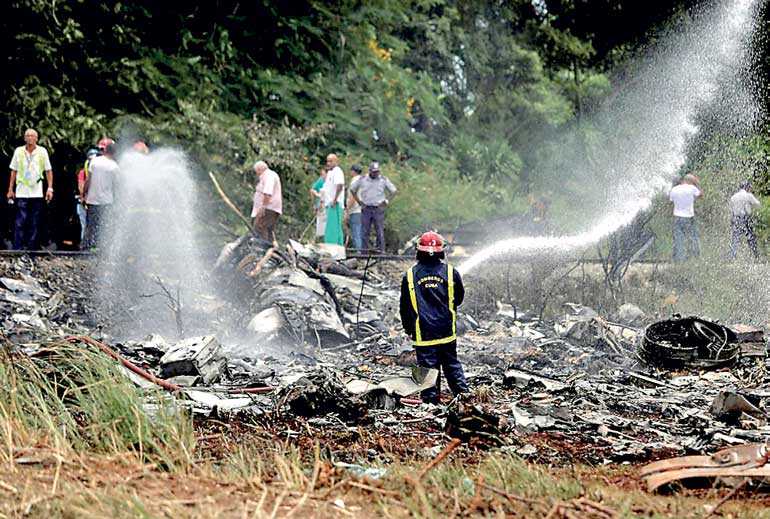Tuesday Mar 11, 2025
Tuesday Mar 11, 2025
Tuesday, 12 June 2018 00:00 - - {{hitsCtrl.values.hits}}
 A firefighter works in the wreckage of a Boeing 737 plane that crashed in the agricultural area of Boyeros, around 20 km (12 miles) south of Havana, shortly after taking off from Havana's main airport in Cuba, May 18, 2018. REUTERS
A firefighter works in the wreckage of a Boeing 737 plane that crashed in the agricultural area of Boyeros, around 20 km (12 miles) south of Havana, shortly after taking off from Havana's main airport in Cuba, May 18, 2018. REUTERS
Sydney (Reuters): Global airlines, coming off a record-low accident rate in 2017, need to guard against complacency over safety as heavy growth in travel demand stretches the air transport system, industry leaders warned at a conference this week.
There were no jet crashes in 2017 and 19 fatalities across the sector, while some 301 passengers have died in five crashes over just the first five months of 2018, including the first fatality on a US airline since 2009. The other fatal accidents occurred in Cuba, Russia, Iran and Nepal.
Air transportation advocates say it is still by far the safest form of travel. But the industry also needs to modernise a fragmented infrastructure and adopt new technology to keep it safe even as demand balloons, delegates at annual talks of the International Air Transport Association (IATA) said.
Alexandre de Juniac, director-general of the group of 280 airlines, called for a continued rigid focus on safety.
“No arrogance in any case: (we need) humility and work,” he said after IATA’s three-day meeting in Sydney.
With IATA forecasting passenger traffic will nearly double by 2036, there are worries over whether the industry will be able to attract and train enough capable pilots and engineers.
Rising congestion in airspace and at airports, some of which are operating above capacity, and poor air traffic control are already posing challenges.
A deadly plane crash in Nepal in March is a case in point.
Airline and airport authorities in Kathmandu have blamed each other after the US-Bangla Airlines crash that killed 49 in what is the Himalayan nation’s worst air disaster since 1992.
The cause of the crash is still under investigation, but a transcript of pilot radio conversations with the ground revealed confusion over the designated runway.
Aviation remains a “very, very safe industry” despite the accidents this year, but there is concern over whether systems can keep pace with future growth, said Peter Harbison, executive chairman of Sydney-based CAPA Centre for Aviation.
“There are worries about having lesser-trained pilots and that creating more risk, or congested airspace, air traffic control that is not adequate to support the services going through,” he said.
New technology for safer skies
IATA executives said new air traffic technology is one of the keys to keeping busy skies safe.
“Implementing technology is expensive and difficult but it is available now,” IATA’s senior vice president of safety and flight operations, Gilberto Lopez Meyer, said on the sidelines of the industry’s biggest annual gathering.
“It is allowing us to reduce separation safely,” he said, referring to the ability for jets to fly closer together in a crowded airspace.
IATA called for airlines to share more safety data and use predictive analytics to prevent accidents.
“We are always on edge, always looking to see what we can learn, what we can improve,” said Alan Joyce, outgoing chairman of the IATA and also the CEO of Qantas Airways Ltd, which has not had a hull loss since the dawn of the jet age.
Although accidents are rare in air travel, with the numbers dropping over the past 15 years, they can lead to significant financial and reputational consequences.
For example, Southwest Airlines expects its second-quarter unit revenue to drop by about 3%`, hurt by lower bookings after a fatal engine blowout in April.
Discover Kapruka, the leading online shopping platform in Sri Lanka, where you can conveniently send Gifts and Flowers to your loved ones for any event including Valentine ’s Day. Explore a wide range of popular Shopping Categories on Kapruka, including Toys, Groceries, Electronics, Birthday Cakes, Fruits, Chocolates, Flower Bouquets, Clothing, Watches, Lingerie, Gift Sets and Jewellery. Also if you’re interested in selling with Kapruka, Partner Central by Kapruka is the best solution to start with. Moreover, through Kapruka Global Shop, you can also enjoy the convenience of purchasing products from renowned platforms like Amazon and eBay and have them delivered to Sri Lanka.
Discover Kapruka, the leading online shopping platform in Sri Lanka, where you can conveniently send Gifts and Flowers to your loved ones for any event including Valentine ’s Day. Explore a wide range of popular Shopping Categories on Kapruka, including Toys, Groceries, Electronics, Birthday Cakes, Fruits, Chocolates, Flower Bouquets, Clothing, Watches, Lingerie, Gift Sets and Jewellery. Also if you’re interested in selling with Kapruka, Partner Central by Kapruka is the best solution to start with. Moreover, through Kapruka Global Shop, you can also enjoy the convenience of purchasing products from renowned platforms like Amazon and eBay and have them delivered to Sri Lanka.